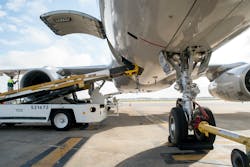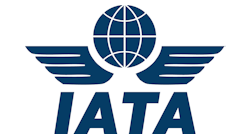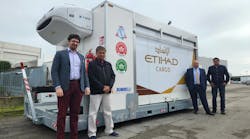Limiting damage to an aircraft while it is on the ramp is a priority for both airlines and ground support personnel. Yet, significant costs associated with ground damage are incurred by airlines on an annual basis.
As a result, industry leaders sought ways to incorporate anti-collision abilities into their ground support equipment. And when the International Air Transport Association (IATA) updated its Airport Handling Manual (AHM) to include language requiring anti-collision capability in belt loaders, cargo loaders, passenger stairs and catering trucks, the urgency to find a solution increased.
While mechanical devices can be installed on pieces of GSE to limit abuse and reduce damage to aircraft on the ground, people like Dan Boucher, president at Powertrain Control Solutions (PCS), urged equipment manufacturers to rethink the transmission being used.
PCS has produced transmission control modules for vehicles since 2003, primarily in the military segment. However, about three years ago, PCS discovered they were a good fit for GSE manufacturers looking to solve issues arising from operators abusing equipment.
GSE with a hydraulic transmission has been used for decades. But with a hydraulic transmission, when the operator moved the shift lever into forward, the transmission would shift into forward – whether it was safe to do so, or not. Drivers might shift from reverse to forward while the vehicle was still moving backwards or perform other maneuvers that damage the transmission and other components like the drive shaft and rear end because of the shock put on the vehicle.
“Airlines started to identify this as an issue,” Boucher says, noting mechanical devices that required the brake to be applied in order to shift into gear could be incorporated in an attempt to limit this damage.
“What we determined was all this abuse protection that the airlines needed, could be accomplished inside the transmission with the calibration and valve body,” he continues. “All the functionality that external equipment provided, we were able to implement inside the transmission.”
An electronic transmission reduces the wear and tear on the axle, suspension and other components in the driveline of a vehicle that is generated from shifting when it’s not safe.
What’s more, an electronic transmission gives the operator the ability to inch the GSE forward or backward while standing next to the equipment, and improved fuel economy can be achieved thanks to a neutral idle function.
Perhaps most importantly, advanced safety capabilities become available. As an example, the transmission, when connected to a position reporting module, could provide geo-fencing abilities that limits the speed of the vehicle based on where it is being operated.
“If you’re near an aircraft, all you have is first gear,” Boucher says. “Whereas, if you’re out on the ramp and can safely operate the vehicle at higher speeds, the transmission will shift into higher gears so you can go faster.”
All of these features protect the investment of the GSE purchaser.
“It really changes the personality and the possibilities of the vehicle once you get the electronic transmission,” Boucher says.
According to Boucher, many GSE manufacturers in the United States have adopted the technology afforded by electronic transmissions. But because of the size of the global GSE fleet, and the fact that hydraulic transmissions are still available in remanufactured units, many units do not utilize an electronic transmission.
“I think the reluctance to it is hydraulic transmissions have been used for decades. People who have spent lots of time in GSE only know the hydraulic transmission, and though it may have its limitations, they know what those are. They’re comfortable with it, and they know how to service it,” he says. “So, I think there’s some hesitation to just switching to something new.”
IATA Airport Handling Manual
Electronic transmissions provide a new level of technology and safety that hadn’t been in the ground support industry previously. That may be reason enough for many to adopt the technology.
But when IATA updated Chapter 9 of its Airport Handling Manual (AHM) to stipulate that belt loaders and other types of ground support equipment would need anti-collision technology installed on them, the onus on adopting the technology increased.
IATA’s AHM sets goals for the industry. In the United States, it is not required to meet the AHM specifications, but it is viewed as a serious reference document that most people in the industry adopt. In Europe the AHM is treated even more earnestly.
GSE program manager at Air Canada, Bill Bender, who serves as the chairman of IATA’s Ground Support Equipment and Environment (GSEE) Task Force, said the significant cost of aircraft damage within the industry was one of the major reasons for adding language encouraging manufacturers to provide anti-collision technology.
“That was a driving factor for the enhancements that we added to the GSE section of the AHM, Bender says, referring to AHM section 910, 913 and 925. “It was the cost of ground damage and employee safety.”
Among other items, Chapter 9 of IATA’s AHM requires that by July 2018, all new belt loaders have some type of anti-collision technology installed on them. Additionally, by July of 2020, the belt loaders in the field need to be retrofitted with this technology.
IATA’s GSEE Task Force writes functional requirements for ground support equipment, explains Scott Barninger, director of GSE at Piedmont Airlines and GSEE Task Force member.
“It’s not really a technical, engineering design document,” he says. “It’s just a functional specification.”
Barninger, who also serves as vice chairman of the SAE AGE-3 Technical Committee, adds that the SAE writes standards that are directed toward manufacturers and the design of the equipment specifically.
“From the airline side, we’re very interested in getting this technology out there,” Barninger says, noting Piedmont Airlines is putting a belt loader with collision-avoidance technology into operation at its Richmond, VA, location.
Three years ago, Bender explains, the Airside Safety Team at IATA came to the GSEE Task Force and asked for enhancements to the standards of GSE that would encourage the development of anti-collision technology to reduce GSE damage to aircraft.
“We wrote it in such a way that it left it open for the individual manufacturers to develop competing designs and produce the best product,” Bender says.
“We started it with four pieces of equipment that interface with the aircraft – belt loaders, container loaders, passenger stairs and catering trucks,” he adds. “We added this section to each one of those standards to help encourage development of collision avoidance or ground damage reduction.”
Bender says the GSEE Task Force knew the challenge was going to be incorporating this technology on conventional drive train units, like those found on a belt loader.
“With the introduction of electronically controlled transmissions, it has allowed some new ideas and technology to come into play that will allow us to control the speeds of this equipment down to a very slow speed, which helps with damage reduction,” says Bender, whose airline is performing an analysis of a belt loader with anti-collision technology at its operation in Toronto.
“I think it’s key that you’re reducing speed,” agrees Barninger. “You’re reducing the energy of the vehicle approaching the aircraft. Even if the technology ultimately fails and permits a contact with the aircraft, you’ve reduced the energy so much that you really minimize any damage.”
In addition to limiting aircraft damage, another critical part of promoting this technology is employee safety and injury prevention.
“By reducing speeds and eliminating – or reducing – the risk of damage, operators don’t put themselves in a risky situation,” Bender says.
Technology in Action
With electronic transmission technology available, and IATA’s airport handling manual requiring the use of collision avoidance, many manufacturers have begun implementing its use.
TUG Technologies, which is part of Textron GSE, utilizes the electronic transmission produced by PCS in its 660 Belt Loader.
“Because we have our technology in the transmission, we can stop the vehicle, we can slow the vehicle” Boucher of PCS explains.
The transmission works in concert with sensors, which TUG calls Smart Sense, located at the front of the belt that detect the distance to the aircraft.
“When you are close to the aircraft, it limits your speed,” Boucher says. “When the belt is up, your speed is limited to essentially a walking speed.”
As the belt continues to get closer to the aircraft, the sensors prevent the belt from being driven into the airplane.
“If you come closer than the programmed distance, it will stop the vehicle and not allow you to drive forward anymore,” says Boucher.
Additionally, explains Brian Yoder – engineering director at Textron GSE, the TUG 660 Belt Loaders equipped with the Smart Sense system provide additional safety features.
Among others, they include parking brake and foot brake shift inhibit; speed limiting with the conveyor raised; automatic stopping if the operator leaves the seat while driving; and a system reset required when the operator speeds or leaves the seat.
“This drives good behaviors,” Yoder explains.
The first TUG belt loaders with Smart Sense were delivered in August of 2016. Smart Sense is currently optional on the company’s belt loaders, and an aftermarket kit is available for TUG 660 units currently in the field.
Yoder says feedback on the TUG 660 with Smart Sense has been positive.
“We were able to deliver exactly what our customers were looking for to prevent accidents on the ramp,” he says. “To ensure a seamless transition for the operators in the field, Textron GSE sends engineers to meet with each new Smart Sense customer when they receive their first unit. We make adjustments to the system in order to make sure it works perfectly in their operation and provide training for the operators.”
Perhaps the most important feature of the Smart Sense system, Yoder notes, is operator behavior is being adjusted rather than automating the vehicle.
“The system actually encourages actions that should be taking place on a regular belt loader, instead of teaching operators irresponsibility when approaching aircraft,” he says. “There are thousands of belt loaders in operation around the world, so it’s important that we introduce a system that maintains a consistent method of operations.”
The result will ideally be fewer accidents on the ramp, and hence a safer work environment.
That is the goal Textron GSE, PCS and IATA are trying to achieve.
“This was a big need in the industry. We had a lot of people asking about what we can do,” Boucher says. “And we’re in the business of making controllers that solve problems. So when we heard that the industry was looking for a solution, we started looking at it, and had some prototypes in development.”
In an effort to “modernize the GSE fleet,” Boucher believes getting information to the end-users is key because of how much technology has advanced.
“It doesn’t have to be scary. It doesn’t have to be expensive,” he says. “In fact, when you calculate the value of what technology can save you in maintenance and costly down-time, it’s a win-win for the airline or service provider from both a time and operation perspective and the bottom line.”







